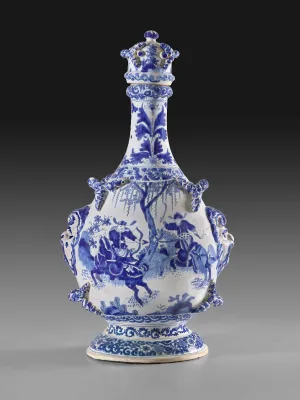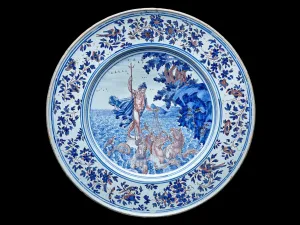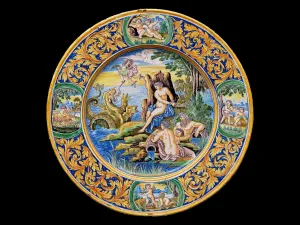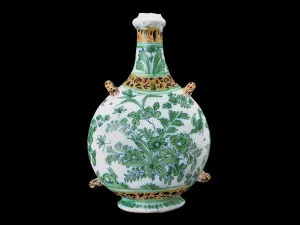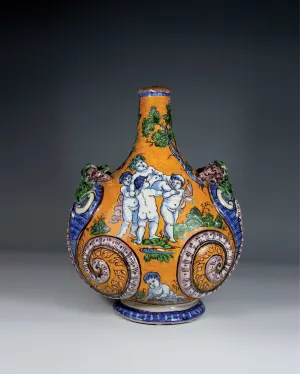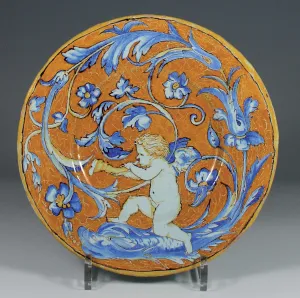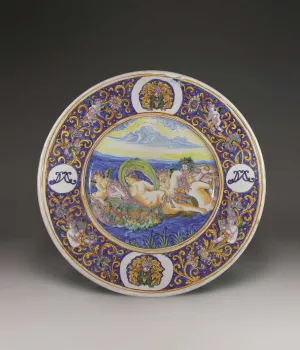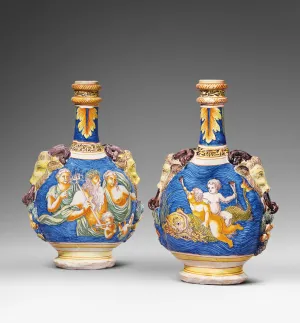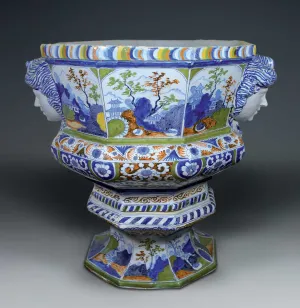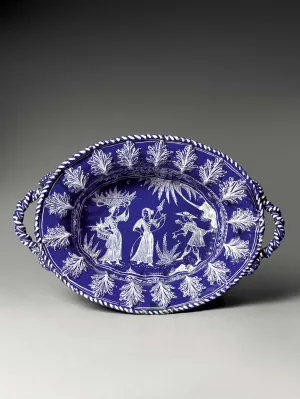Nevers: The Golden Age Of French Faience
The production of Nevers continued to be inspired by Italian Renaissance maiolica until the end of the seventeenth century (cats. 22, 24, 25, 26, 27), even though maiolica production in Italy was in decline. Neverian potters and painters became inspired by ceramics from Persia (see, for example, the platter) and Delftware (cat. 21). Delftware was, in turn, inspired by Chinese porcelain, primarily blue and white, which the East India Company had been importing to Holland since its founding in 1602.
Potters and painters in Nevers also created new colors and a wide range of decorative styles, gradually developing a unique character. For example, they invented an emerald green that was used to decorate both borders and entire pieces, such as the pilgrim flask (cat. 23). They also produced pieces decorated with scenes mixing Chinese and Turkish influences, as seen on the gourd painted in monochrome blue with Chinese warriors on horseback on one side and Turks in an Asian-style landscape on the other (cat. 17). When pieces were painted with colorful mythological scenes, or istoriati, in the tradition of Italian Renaissance maiolica, these were now surrounded by decorative borders newly created at Nevers (cats. 21, 22, 26).
During the seventeenth century, faience was still very costly and therefore acquired, collected, and gifted exclusively by patrons at the highest levels of French society. These dishes, plates, gourds, and flasks were not intended for use but instead for display on a credenza. In rare instances, a coat-of-arms or a cypher, like the unidentified one on the dish (cat. 26), was added to celebrate the illustrious owner.
Gourd
Nevers, ca. 1670−80
Faience (tin-glazed earthenware)
H. 17 3/8 in. (44 cm), W. 9 in. (23 cm)
Cat. 17
© The Frick Collection
Plate
Nevers, ca. 1680−85
Faience (tin-glazed earthenware)
Diam. 22 3/8 in. (56.8 cm)
Cat. 21
© The Frick Collection
Plate
Nevers, ca. 1680−90
Faience (tin-glazed earthenware)
Diam. 22 1/8 in. (56.2 cm)
Cat. 22
© The Frick Collection
Flask
Nevers, ca. 1680−90
Faience (tin-glazed earthenware)
H. 11 in. (28 cm), W. 7 in. (17.8 cm)
Cat. 23
© The Frick Collection
Gourd
Nevers, ca. 1680−90
Faience (tin-glazed earthenware)
H. 14 5/8 in. (37 cm), W. 11 in. (28 cm)
Cat. 24
© Christophe Perlès
Plate
Nevers, ca. 1680−90
Faience (tin-glazed earthenware)
Diam. 9 1/4 in. (23.5 cm)
Cat. 25
© Christophe Perlès
Dish
Nevers, ca. 1680−1700
Faience (tin-glazed earthenware)
Diam. 18 3/4 in. (47.7 cm)
Cat. 26
© Christophe Perlès
Pair of Flasks
Nevers, ca. 1680−1700
Faience (tin-glazed earthenware)
H. 13 1/8 in. (33.4 cm), W. 8 1/2 in. (22 cm)
Cat. 27
© Christie's
Orange-Tree Planter
Nevers, ca. 1680
Faience (tin-glazed earthenware)
H. 25 in. (63.5 cm), W. 27 in. (68.6 cm), D. 21 1/8 in (54 cm)
Cat. 20
© Christophe Perlès
Over the years, Nevers potters and painters refined the technique of tin-glazed earthenware, which enabled them to produce larger and more ambitious objects, like this rare tree planter, the largest faience piece known today. Its general shape was influenced by contemporary architecture, and the two large heads of Apollo on each side are characteristic of the Baroque style developed at the court of Versailles under Louis XIV.
Ewer
Possibly forming a set with Basin
Nevers, ca. 1680
Faience (tin-glazed earthenware)
H. 27 1/2 in. (70 cm), W. 13 in. (33 cm)
Cat. 18
© Christophe Perlès
This ewer and the recently discovered basin are the most beautiful known pieces made with the famous dark blue background known as “Nevers blue,” invented in the second half of the seventeenth century in Nevers. Their shapes recall silver pieces used at the court of Louis XIV while their painted decoration — with figures wearing turbans, a shepherdess spinning a distaff, and peddlers — is inspired by early seventeenth-century French literature, including the novel L’Astrée by Honoré d’Urfé, published between 1607 and 1627.
Basin
Possibly forming a set with Ewer
Nevers, ca. 1680
Faience (tin-glazed earthenware)
H. 19 1/4 in. (49 cm), L. 22 3/4 in. (58 cm)
Cat. 19
© Camille Leprince
This recently discovered basin and the ewer are the most beautiful known pieces made with the famous dark blue background known as “Nevers blue,” invented in the second half of the seventeenth century in Nevers. Their shapes recall silver pieces used at the court of Louis XIV while their painted decoration — with figures wearing turbans, a shepherdess spinning a distaff, and peddlers — is inspired by early seventeenth-century French literature, including the novel L’Astrée by Honoré d’Urfé, published between 1607 and 1627.

